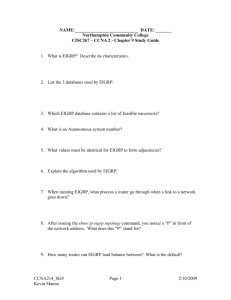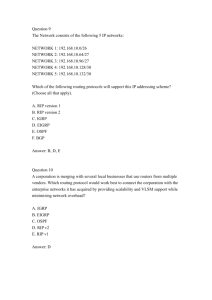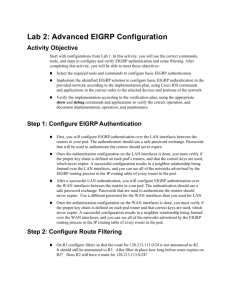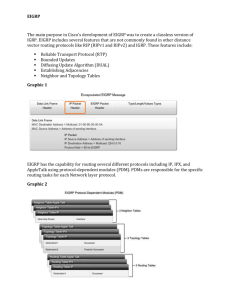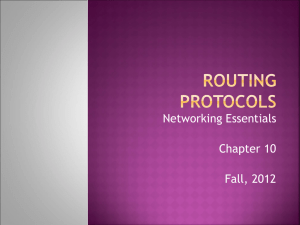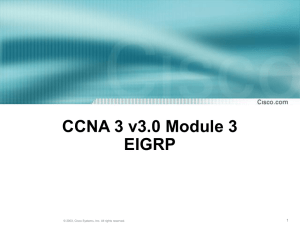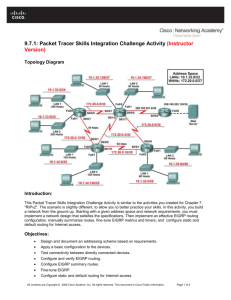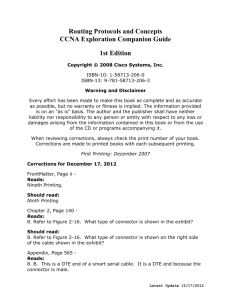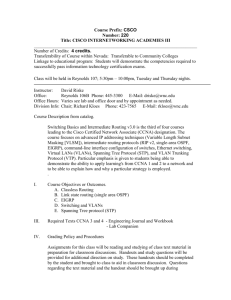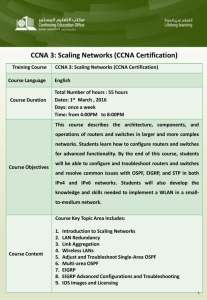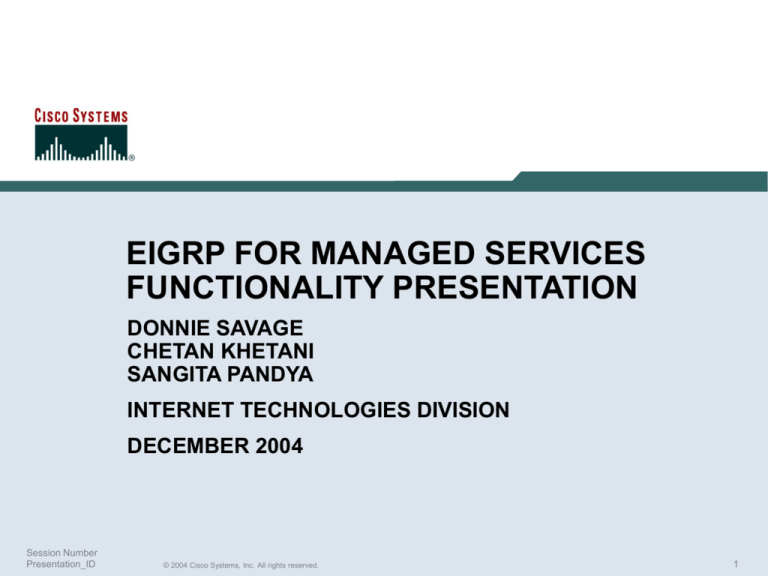
EIGRP FOR MANAGED SERVICES
FUNCTIONALITY PRESENTATION
DONNIE SAVAGE
CHETAN KHETANI
SANGITA PANDYA
INTERNET TECHNOLOGIES DIVISION
DECEMBER 2004
Session Number
Presentation_ID
© 2004 Cisco Systems, Inc. All rights reserved.
1
Agenda
• INTRODUCTION AND TECHNOLOGY OVERVIEW
• Functionality Description
EIGRP Route Propagation Behaviour
EIGRP Changes
Operation
• Scenarios
• Configuration and Troubleshooting
Presentation_ID
© 2004 Cisco Systems, Inc. All rights reserved.
2
VPN for Many Managed Services
V i r t u a l
P r i v a t e
MANAGED
Routing
MANAGED Security
MANAGED
CPE
MANAGED
Internet Gateway
N e t w o r k
MANAGED
IPT
Service Provider
Converged Network
Service Level
Agreement for
MANAGED Services
MANAGED
Extranet
VM
VM
VPN B
Customer
Branch
Presentation_ID
Customer HQ
© 2004 Cisco Systems, Inc. All rights reserved.
3
Managed Routing Revenue Opportunity
Over 50% of Cisco Enterprise Customers Deploy
IP Routing with EIGRP
IP/MPLS VPN Backbone
PE-3
PE-1
PE-2
CE-1
CE-2
EIGRP AS-1
Presentation_ID
© 2004 Cisco Systems, Inc. All rights reserved.
EIGRP AS-1
4
Cisco
Exclusive
Robust EIGRP Support
Cisco IOS Supports the Industry’s Most Comprehensive and
Robust Routing Protocol Support: RIP, OSPF, BGP, ISIS,
Including EIGRP
VPN C/Site 2
CEA2
CE1B1
12.1/16
CEB2
Static
RIPv2
16.2/16
RIPv2
P1
PE2
VPN B/Site 2
BGP
RIPv2
PE1
P2
CEA3
OSPF
OSPF
CEA1
16.2/16
P3
BGP
PE3
VPN A/Site 2
CEB3
VPN A/Site 1
16.1/16
12.2/16
VPN C/Site 1
BENEFITS:
Service Provider: Simplest point of entry into enterprise’s existing architecture
Enterprise: Least disruption to current network design
Presentation_ID
© 2004 Cisco Systems, Inc. All rights reserved.
5
Managed EIGRP
Benefits for SPs and Enterprises:
• Impose little requirements or no restrictions on
customer networks
• CE and C routers are NOT required to run newer code
(CE/C upgrades recommended for full SoO functionality)
• Customer sites may be same or different Autonomous
Systems
• Customer sites may consist of several connections to
the MPLS VPN backbone
• Customer sites may consist of one or more connections
not part of the MPLS VPN backbone (“backdoor” links)
Presentation_ID
© 2004 Cisco Systems, Inc. All rights reserved.
6
Technology Overview:
MPLS VPN Network
PE-CE Routing Protocol
EIGRP, Static,RIPv2,EBGP,OSPF
VPN_A
10.2.0.0
VRF Interface
VPN_A
11.5.0.0
MPLS Core
CE
CE
VPN_B
10.2.0.0
P
CE
VPN_A
10.1.0.0
P
PE
PE
CE
LDP
VPN_A
11.6.0.0
P
P
CE
Customer Edge
CE
MP-BGP Sessions
CE
Presentation_ID
PE
PE
VPN_B
10.1.0.0
VPN_B
10.3.0.0
Provider Router
© 2004 Cisco Systems, Inc. All rights reserved.
Provider Edge
7
Technology Overview:
EIGRP for MPLS VPN PE-CE
CEA2
VPN B/Site 1
CE1B1
16.1/16
VPN C/Site 2
12.1/16
CEB2
EIGRP
EIGRP
EIGRP
P1
2
CE B1
EIGRP
BGP
PE1
PE2
VPN B/Site 2
P2
EIGRP
CEA1
16.2/16
CEA3
EIGRP
16.2/16
P3
EIGRP
PE3
VPN A/Site 2
CEB3
16.1/16
VPN A/Site 1
Presentation_ID
© 2004 Cisco Systems, Inc. All rights reserved.
12.2/16
VPN C/Site 1
8
Technology Overview:
MPLS VPN Routes Distribution
CEA2
VPN B/Site 1
CE1B1
16.1/16
CE B1
12.1/16
EIGRP
EIGRP
BGP
PE1
PE2
CEA3
Step 4
Step 2
EIGRP
Step 5
CEA1
P3
16.2/16
VPN B/Site 2
P2
Step 3
Step 1
EIGRP
CEB2
EIGRP
EIGR
P
P1
2
VPN C/Site 2
EIGRP
16.2/16
PE3
VPN A/Site 2
CEB3
16.1/16
VPN A/Site 1
Presentation_ID
© 2004 Cisco Systems, Inc. All rights reserved.
12.2/16
VPN C/Site 1
9
Technology Overview:
Routing Information Distribution
• Step 1: From site (CE) to service provider (PE)
E.g. EIGRP, RIPv2, OSPF, or BGP (or static routing on PE)
• Step 2: Export to provider’s BGP at ingress PE
• Step 3: Within/across service provider(s)
(among PEs):
Via MP-IBGP
• Step 4: Import from provider’s BGP at egress PE
• Step 5: From service provider (PE) to site (CE)
E.g. EIGRP, RIPv2, OSPF, or BGP (or static routing on PE)
Presentation_ID
© 2004 Cisco Systems, Inc. All rights reserved.
10
Technology Overview:
EIGRP PE/CE Deployment
• In this network, we have two
corporate sites, connected
by a leased line and VPN
through a service provider
SERVICE PROVIDER
VPN
B
• EIGRP routes redistributed
into BGP at B, and back into
EIGRP at C, appear as
external routes at Site 2
We want them to appear as
internal routes
C
A
SITE 1
D
EXTERNAL
SITE 2
Presentation_ID
© 2004 Cisco Systems, Inc. All rights reserved.
11
Technology Overview:
EIGRP PE/CE Deployment
• As routes are redistributed
into BGP as B, extended
communities containing the
EIGRP metrics are attached
to them
• As routes are redistributed
back into EIGRP at C, these
extended communities are
used to reconstruct the
routes as internals
SERVICE PROVIDER
VPN
B
C
A
SITE 1
D
• The VPN is considered
a 0 cost link in this
configuration
INTERNAL
SITE 2
Presentation_ID
© 2004 Cisco Systems, Inc. All rights reserved.
12
Technology Overview:
EIGRP PE/CE Deployment
ip vrf VRF-RED
rd 172.16.0.1:20
exit
....
router eigrp 1
B
address-family ipv4 vrf VRF-RED
autonomous-system 101
network 172.16.0.0 255.255.0.0
redistribute BGP 101 metric 10000 100 255 1 1500
exit-address-family
SERVICE PROVIDER
VPN
C
A
SITE 1
D
router-c#show ip eigrp vrf VRF-RED topology
IP-EIGRP Topology Table for AS(1)/ID(192.168.10.1)
Routing Table:VRF-PINK
P 10.17.17.0/24, 1 successors, FD is 409600
via 50.10.10.2 (409600/128256), Ethernet3/0
P 172.16.19.0/24, 1 successors, FD is 409600
Presentation_ID
© 2004 Cisco Systems, Inc. All rights reserved.
INTERNAL
SITE 2
13
Technology Overview:
EIGRP PE/CE Deployment
• 12.0(27)SV 12.0(21.1)SY2
12.0(21.1)S2
SERVICE PROVIDER
• Backdoor links were not
supported
VPN
B
• http://www.cisco.com/en/US/
products/sw/iosswrel/ps183
9/products_feature_guide09
186a0080154db3.html
C
A
SITE 1
D
NO BACKDOOR LINK
SITE 2
Presentation_ID
© 2004 Cisco Systems, Inc. All rights reserved.
14
Technology Overview:
EIGRP PE/CE Backdoor Links
• The biggest danger with
backdoor links is possible
routing loops
SERVICE PROVIDER
VPN
Site1 advertises a network
through the back door to site 2
B
C
C prefers this route, and
redistributes it into BGP
B prefers the BGP route, and
redistributes it into EIGRP,
forming a loop
• The solution is to
automatically tag all the
routes originating in site 1
so they will be rejected by C
• This tag is called the Site of
Origin (SoO)
Presentation_ID
© 2004 Cisco Systems, Inc. All rights reserved.
A
SITE 1
D
SITE 2
15
Technology Overview:
EIGRP PE/CE Backdoor Links
• The SoO is set on all PE routers
on the interface connecting to the
PE, and on backdoor link routers
• The CE will always reject
the marked EIGRP learned
routes, and prefer the BGP
learned routes
SERVICE PROVIDER
VPN
B
• You can then set the backdoor
link so the path through the
SITE 1
VPN is always preferred over
the backdoor link
route-map SoOrigin permit
C
A
D
10
set extcommunity soo 100:1
....
interface FastEthernet 0/0
ip vrf sitemap SoOrigin
SITE 2
....
Presentation_ID
© 2004 Cisco Systems, Inc. All rights reserved.
16
Technology Overview:
EIGRP MIB Support
• EIGRP Traffic Statistics
• EIGRP Interface Data
AS Number
Peer Count
Hellos Sent/Received
Reliable/Unreliable Queues
Updates Sent/Received
Pacing
Queries Sent/Received
Pending Routes
Replies Sent/Received
Hello Interval
• EIGRP Topology Data
• EIGRP Neighbor Data
Destination Net/Mask
Peer Address
Active State
Peer Interface
Feasible Successors
Hold Time
Origin Type
Up Time
Distance
SRTT/RTO
Reported Distance
Version
AND MANY MORE…
Presentation_ID
© 2004 Cisco Systems, Inc. All rights reserved.
17
Technology Overview:
EIGRP PE/CE Prefix Limits
• Generic Redistribution: To limit the
number of redistributed routes/prefixes
• MPLS VPN PE-CE:
To limit the number
of prefixes on a
given PE router as
follows:
For the whole VPN or
For individual
CEs/neighbors
CE
CE
CE
CE
CE
PE
BGP/MPLS VPN
With EIGRP between PE-CE
CE
CE
CE
CE
PE
PE
CE
CE
PE1
PE
PE
CE
CE
VRF1
…
VRF2
VRFL+1
VRF3 VRFL
CE
CE
CE
• neighbor maximum-prefix <maximum> [<threshold>] [warning-only] [[restart <restart
interval>][restart-count <count>][reset-time <reset interval>][dampened]]
• redistribute maximum-prefix <maximum> [<threshold>] [warning-only][[restart <restart interval>]
[restart-count <count>] [reset-time <reset interval>][dampened]]
Presentation_ID
© 2004 Cisco Systems, Inc. All rights reserved.
18
Summary
• Native EIGRP on PE to CE links
Avoids translating all EIGRP routes to external routes
Redistribution of EIGRP metrics preserved across BGP cloud though use
of Extended Community attributes
• Impose little requirements or no restrictions on
customer networks
CE and C routers are NOT required to run newer code
(CE/C upgrades recommended for full SoO functionality)
Customer sites may be same or different Autonomous Systems
Customer sites may consist of several connections to the MPLS VPN
backbone
Customer sites may consist of one or more connections not part of the
MPLS VPN backbone (“backdoor” links) Note: Backdoor links—EIGRP
Site of Origin is not supported in the initial release; this support was
added in 12.3(8)T and 12.0.27S
Presentation_ID
© 2004 Cisco Systems, Inc. All rights reserved.
19
Summary (Cont.)
• EIGRP Route Type and Metric Preservation
The MPLS VPN backbone is running BGP; Normal redistribution of EIGRP
into BGP and vice versa on the PE’s results in intersite EIGRP routes
appearing as external routes resulting in all routes traversing the MPLS
VPN backbone becoming less preferable than the routes that do not
traverse the MPLS VPN backbone
To solve this;
If the sites are non-EIGRP: PE’s originate External EIGRP routes using
the configured default metric; if no default metric is configured, the
routes will not be redistributed into EIGRP
If the sites are in different EIGRP Autonomous System: PE’s
originate External EIGRP routes using the configured default metric;
if no default metric is configured, the routes will not be redistributed
into EIGRP
if the sites are in the same EIGRP Autonomous System: PE’s originate
EIGRP routes using the originating EIGRP metrics and route types
from the originating EIGRP AS
Presentation_ID
© 2004 Cisco Systems, Inc. All rights reserved.
20
Agenda
• Introduction and Technology Overview
• FUNCTIONALITY DESCRIPTION
EIGRP Route Propagation Behaviour
EIGRP Changes
Operation
• Scenarios
• Configuration and Troubleshooting
Presentation_ID
© 2004 Cisco Systems, Inc. All rights reserved.
21
EIGRP Route Propagation Behavior
MPLS VPN Backbone
AS-1
AS-1
10.1.x.x
10.3.x.x
AS-2
10.2.x.x
Presentation_ID
© 2004 Cisco Systems, Inc. All rights reserved.
22
EIGRP Route Propagation Behavior
EIGRP
Internal
MPLS VPN Backbone
AS-1
EIGRP
Internal
AS-1
10.1.x.x
EIGRP
Internal
10.3.x.x
AS-2
10.2.x.x
EIGRP Routes Are Advertised into BGP Backbone Preserving
the EIGRP Route Type and Metric Information in the BGP
Extended Community Attribute
Presentation_ID
© 2004 Cisco Systems, Inc. All rights reserved.
23
EIGRP Route Propagation Behavior
EIGRP AS1: Internal
EIGRP AS2: External
MPLS VPN Backbone
AS-1
EIGRP AS1: Internal
EIGRP AS2: External
AS-1
10.1.x.x
10.3.x.x
EIGRP AS1: External
AS-2
10.2.x.x
BGP Redistributes Routes into EIGRP Using Route Type and
Metric Information Extracted from BGP Extended Community
Information
Presentation_ID
© 2004 Cisco Systems, Inc. All rights reserved.
24
Route Redistribution
and Avoiding Routing Loop
VPN-IPv4 Update
RD:Net-1, Next-hop=PE-1
RT=xxx:xxx
MPLS-VPN Backbone
EIGRP-Route-Type= internal
EIGRP-VecMetric=B,L,D,R.M,H
PE-3
PE-1
EIGRP redistributes
into BGP:
PE-2
EIGRP-Route-Type= internal
EIGRP-VecMetric=B,L,D,R.M,H
CE-1
CE-2
EIGRP originates as Internal
Route with initial
BW, Load, Delay, Reliability,
MTU, Hop
Presentation_ID
EIGRP AS-1
© 2004 Cisco Systems, Inc. All rights reserved.
EIGRP AS-1
25
Route Redistribution
and Avoiding Routing Loop
MPLS-VPN Backbone
BGP redistributes into EIGRP :
EIGRP-Route-Type= internal
EIGRP-VecMetric=B,L,D,R.M,H
PE-3
PE-1
PE-2
CE-1
CE-2
EIGRP AS-1
Presentation_ID
© 2004 Cisco Systems, Inc. All rights reserved.
EIGRP AS-1
26
Route Redistribution
and Avoiding Routing Loop
MPLS-VPN Backbone
EIGRP computes new VecMetric:
EIGRP-Route-Type= internal
EIGRP-VecMetric=B,L,D,R.M,H
PE-3
PE-1
PE-2
CE-1
CE-2
EIGRP AS-1
EIGRP AS-1
EIGRP installs Route as:
Internal, BW, Load, Delay, Reliability, MTU, Hop
Presentation_ID
© 2004 Cisco Systems, Inc. All rights reserved.
27
Route Redistribution
and Avoiding Routing Loop
MPLS-VPN Backbone
CE-2 uses split horizon
to prevent route
reflection to PE-3
PE-3
PE-1
PE-2
CE-1
PE-2 sees higher cost
from CE-2 than PE-1 so
EIGRP AS-1
will not redistribute route
back into BGP
Presentation_ID
© 2004 Cisco Systems, Inc. All rights reserved.
CE-2
EIGRP AS-1
28
Operation: General
• CE runs EIGRP as before
• PE runs an EIGRP-VRF process per vrf/AS
• EIGRP routes are distributed to sites customer via MP-iBGP on the
MPLS-VPN backbone
• Each EIGRP-VRF process needs to be redistributed into MP-iBGP
and vice-versa
• MP-iBGP will carry extended community information across the
MPLS-VPN backbone to other customer sites
• BGP Basic Configuration
Address-family vpnv4
neighbor x.x.x.x activate
neighbor x.x.x.x send-community extended
Address-family ipv4 vrf <vrf-name>
redistribute EIGRP <AS>
no auto-summary
no synchronization
exit-address-family
Presentation_ID
© 2004 Cisco Systems, Inc. All rights reserved.
29
New Extended Communities
• MPLS/VPN backbone is MP-BGP
• There are no EIGRP adjacencies or EIGRP updates
in MPLS/VPN backbone
• EIGRP information is carried across MPLS/VPN
backbone by MP-BGP in new extended
communities (set and used by PE’s)
Presentation_ID
© 2004 Cisco Systems, Inc. All rights reserved.
30
New Extended Communities:
EIGRP Information
• Type 0x8800
• Usage: EIGRP Route Metric information Appended
• Values: Flags + TAG
Presentation_ID
© 2004 Cisco Systems, Inc. All rights reserved.
31
New Extended Communities:
EIGRP Metric Information
• Type 0x8801
• Usage: EIGRP Route Metric information Appended
• Values: AS + Delay
• Type 0x8802
• Usage: EIGRP Route Metric Information
• Values: Reliability + Hop + BW
• Type 0x8803
• Usage: EIGRP Route Metric Information
• Values: Reserve +Load + MTU
Presentation_ID
© 2004 Cisco Systems, Inc. All rights reserved.
32
New Extended Communities:
EIGRP External Information
• Type 0x8804
• Usage: EIGRP Ext Route Information
• Values: Remote AS + Remote ID
• Type 0x8805
• Usage: EIGRP Ext Route Information
• Values: Remote Protocol + Remote Metric
Presentation_ID
© 2004 Cisco Systems, Inc. All rights reserved.
33
New Extended Communities:
EIGRP External Protocol
• External Protocol—Defines the external protocol
that this route was learned by; the following values
are assigned:
Presentation_ID
IGRP-1
OSPF-6
EGRP-2
IS-IS-7
Static-3
EGP-8
RIP-4
BGP-9
HELLO-5
IDRP-10
© 2004 Cisco Systems, Inc. All rights reserved.
34
Operation: PE—Metric Preservation
• EIGRP metric can be set on the PE by the command:
redistribute BGP <as> metric B D R L M
Used to set the metric for BGP routes redistributed into EIGRP
EIGRP will look for BGP extended community information, and if
found, use BGP extended community information to recreate the
original EIGRP route; if the extended community information is
missing, the metric values provided will be used for the external
route created
default-metric B D R L M
Used to set the metric for any non-eigrp route being redistributed
into EIGRP
If the Route is BGP, EIGRP will look for BGP extended community
information, and if found, use BGP extended community information
to recreate the original EIGRP route; if the extended community
information is missing, the metric values provided will be used for
the external route created
• B=Bandwidth D=Delay R=Reliability L=Load M=MTU
Presentation_ID
© 2004 Cisco Systems, Inc. All rights reserved.
35
Operation: PE—Non-EIGRP Routes
• If a route is received via BGP, and the route has no
extended community information for EIGRP:
The route will be advertised to the CE as an external EIGRP
route using the metric supplied on the redistribution or
default-metric statement; if no metric is configured, the
route will not be advertised to the CE
Presentation_ID
© 2004 Cisco Systems, Inc. All rights reserved.
36
Operation: PE—Same AS
• If a route is received via BGP with extended
community information for EIGRP and the AS
number matches:
The route is advertised to the CE as the same type of route
(Int/Ext) as it was in the originating site
The Extended Community information will be used to set
the metric with the VPN itself appearing as a zero-cost link
Recreated External routes will also contain all of the
external data associated with the route in the originating
site (originating router, originating protocol, etc.)
Presentation_ID
© 2004 Cisco Systems, Inc. All rights reserved.
37
Operation: PE—Different AS
• If a route is received via BGP with extended
community information for EIGRP and the AS
number doesn’t match:
The route is advertised to the CE as an external EIGRP
route; the route will *NOT* use the Extended Community
information as it did not originate from the same AS
Presentation_ID
© 2004 Cisco Systems, Inc. All rights reserved.
38
Agenda
• Introduction and Technology Overview
• Functionality Description
EIGRP Route Propagation Behaviour
EIGRP Changes
Operation
• SCENARIOS
• Configuration and Troubleshooting
Presentation_ID
© 2004 Cisco Systems, Inc. All rights reserved.
39
Scenarios
• Customer sites all belong to the same EIGRP
autonomous system
• Customer sites have “BACKDOOR” links
• Customer sites belong to different EIGRP
autonomous systems
• Customer sites contain one or more non-EIGRP site
Presentation_ID
© 2004 Cisco Systems, Inc. All rights reserved.
40
Operation: Single AS Scenario
• Routes are redistributed from EIGRP into MP-BGP
on the sending PE, with the route information
encoded in the Extended Community attributes
• Routes are recreated by receiving PE and sent to
the CE as an EIGRP route; the same route type and
metric as the original route will be used to recreate
the EIGRP route
• The recreated route will be sent to the CE from the
receiving PE with the same metric it contained on
the sending PE
• Note: the MPLS/VPN link looks like it has
Zero metric
Presentation_ID
© 2004 Cisco Systems, Inc. All rights reserved.
41
Operation: Single AS Scenario
MPLS VPN Super Backbone
PE
VPNv4 Route
Network X
Presentation_ID
Internal or
External
PE
Internal or
External
VPN Red
VPN Red
AS-1
AS-1
© 2004 Cisco Systems, Inc. All rights reserved.
Original
Route
recreated
42
Operation: Single AS with
“Backdoor” Link Scenario
• Routes are redistributed from EIGRP into MP-BGP on the
sending PE, with the route information encoded in the
Extended Community attributes
• Routes are recreated by receiving PE and sent to the CE as an
EIGRP route; the same route type and metric as the original
route will be used to recreate the EIGRP route
• The recreated route will be sent to the CE from the receiving
PE with the same metric it contained on the sending PE
• Note: the MPLS/VPN link looks like it has Zero metric
• The path each site will use to reach prefixes belonging to the
other site will be based on metric
• The backdoor link can be only as a failover by increasing
its metric
Presentation_ID
© 2004 Cisco Systems, Inc. All rights reserved.
43
Operation: Single AS with
“Backdoor” Link Scenario
MPLS VPN Super Backbone
PE
PE
Network X
VPNv4 Route
Internal or
External
Internal or
External
Internal or
External
Internal or
External
Original
Route
recreated
Internal or
External
VPN Red
VPN Red
AS-1
AS-1
Backdoor Link
Presentation_ID
© 2004 Cisco Systems, Inc. All rights reserved.
44
Operation: Multiple AS Scenario
• Routes are redistributed from EIGRP into MP-BGP on the
sending PE, with the route information encoded in the
Extended Community attributes
• On PEs running the same EIGRP AS, the routes are recreated
and sent to the CE as an EIGRP route
The same route type and metric as the original route will be used to
recreate the EIGRP route
The recreated route will be sent to the CE from the receiving PE with the
same metric it contained on the sending PE
• On PEs running a different EIGRP AS, the routes are
redistributed into EIGRP as External routes (originating
protocol = BGP)
The redistribution metric will be used for these routes
Presentation_ID
© 2004 Cisco Systems, Inc. All rights reserved.
45
Operation: Multiple AS Scenario
MPLS VPN Super Backbone
VPNv4 Route
PE
Internal
PE
PE
PE
Network X
VPN Red
VPN Red
AS-1
AS-1
Route
Recreated
As Internal
Presentation_ID
External
Internal
© 2004 Cisco Systems, Inc. All rights reserved.
VPN Red
Route Created as
External using
configured default
metric
AS-2
46
Operation: Non-EIGRP Scenario
• Routes are redistributed from some other protocol
into MP-BGP on the sending PE, without the
Extended Community attributes
• Since there are no Extended Community attributes,
the routes are redistributed into EIGRP on the
receiving PE as External routes, with the originating
protocol appearing as BGP
• The redistribution metric defined on the
“redistribute bgp” or “default-metric” statement will
be used to determine the metric on the
redistributed External routes
Presentation_ID
© 2004 Cisco Systems, Inc. All rights reserved.
47
Operation: Non-EIGRP Scenario
MPLS VPN Super Backbone
PE
PE
Network X
Presentation_ID
VPNv4 Route
Redistributed
into BGP
Route Created as
External using
configured default
metric
External
VPN Red
VPN Red
OSPF
EIGRP AS1
© 2004 Cisco Systems, Inc. All rights reserved.
48
Agenda
• Introduction and Technology Overview
• Functionality Description
EIGRP route propagation behavior
EIGRP changes
Operation
• Scenarios
• CONFIGURATION AND TROUBLESHOOTING
Presentation_ID
© 2004 Cisco Systems, Inc. All rights reserved.
49
Configuration
• New config commands:
Support for address-family syntax added
• One EIGRP Router process can support multiple EIGRP-VRF
processes
The number of EIGRP-VRF processes is limited to the available
system resources and the number of supported VRFs on a
given platform
For example:
EIGRP Router Process
router EIGRP 1
address-family ipv4 vrf vrf-red
autonomous-system 69
EIGRP-VRF Process
• There is always an EIGRP-VRF process created for the default
routing table
Presentation_ID
© 2004 Cisco Systems, Inc. All rights reserved.
50
Configuration
• The AS used by a given EIGRP-VRF process is
bounded to the scope of the VRF it is configured for
• For example:
router EIGRP 42
address-family ipv4 vrf vrf-red
autonomous-system 42
address-family ipv4 vrf vrf-green
autonomous-system 42
• All of the three EIGRP-VRF processes are unique
and will NOT share neighbors, routing information,
or topology information
Presentation_ID
© 2004 Cisco Systems, Inc. All rights reserved.
51
Configuration Single Instance
router EIGRP 1
network 10.0.0.0
Commands for Default
Routing Table
address-family ipv4 vrf vrf-red
network 42.0.0.0
autonomous-system 42
Commands for vrf-red
redistribute BGP 100 metric 10000 100 255 1 1500
exit-address-family
address-family ipv4 vrf vrf-green
network 49.0.0.0
Commands for vrf-green
antonymous-system 99
redistribute BGP 101 metric metric 10000 100 255 1 1500
exit-address-family
no eigrp log-neighbor-changes
Presentation_ID
© 2004 Cisco Systems, Inc. All rights reserved.
Commands for Default
Routing Table
52
Configuration Multiple Instance
router EIGRP 1
address-family ipv4 vrf vrf-red
Commands for Default
Routing Table
network 42.0.0.0
autonomous-system 42
redistribute BGP 100 metric 10000 100 255 1 1500
Commands for vrf-red
exit-address-family
no eigrp log-neighbor-changes
router EIGRP 2
Commands for Default
Routing Table
address-family ipv4 vrf vrf-green
network 49.0.0.0
autonomous-system 99
Commands for vrf-green
redistribute BGP 101 metric 10000 100 255 1 1500
exit-address-family
no eigrp log-neighbor-changes
Presentation_ID
© 2004 Cisco Systems, Inc. All rights reserved.
Commands for Default
Routing Table
53
Troubleshooting
• Show commands
show ip EIGRP <VRF vrf-name> <AS> event
show ip EIGRP <VRF vrf-name> <AS> neighbor
show ip EIGRP <VRF vrf-name> <AS> interface
show ip EIGRP <VRF vrf-name> <AS> topology
show ip protocol <VRF vrf-name>
• Note:
use “ * ” as the vrf-name to specify all vrfs
Presentation_ID
© 2004 Cisco Systems, Inc. All rights reserved.
54
Troubleshooting
• Clear commands
clear ip EIGRP <VRF vrf-name> <AS> event
clear ip EIGRP <VRF vrf-name> <AS> neighbor
*clear ip EIGRP <VRF vrf-name> <AS> topology
• Note:
Hidden command
use “ * ” as the vrf-name to specify all vrfs
Presentation_ID
© 2004 Cisco Systems, Inc. All rights reserved.
55
Troubleshooting
• Debug commands
debug ip EIGRP <VRF vrf-name> <AS>
debug ip EIGRP <VRF vrf-name> <AS> neighbor
debug ip EIGRP <VRF vrf-name> <AS> notifications
debug ip EIGRP <VRF vrf-name> <AS> summary
• Note:
use “ * ” as the vrf-name to specify all vrfs use
Presentation_ID
© 2004 Cisco Systems, Inc. All rights reserved.
56
Presentation_ID
© 2004 Cisco Systems, Inc. All rights reserved.
57

